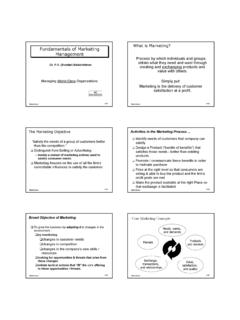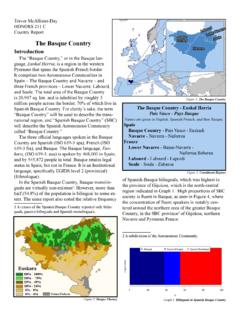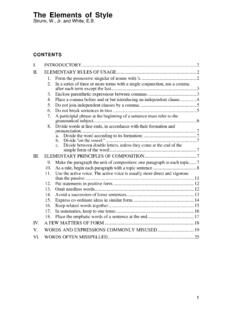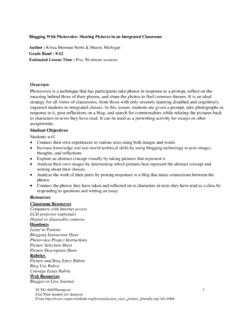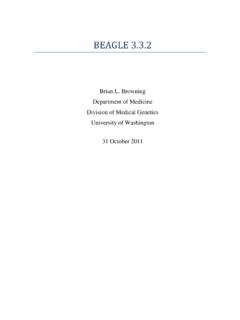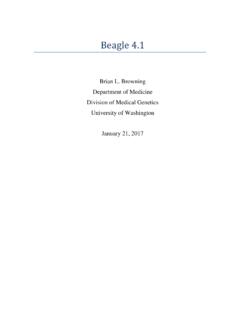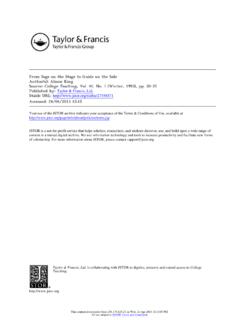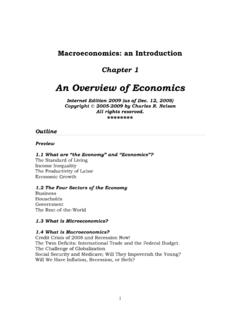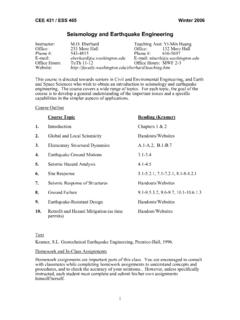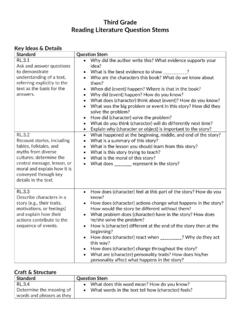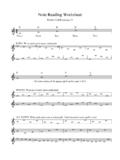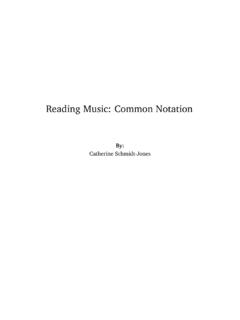Transcription of Chapter 10 The Hydrogen Atom - University of Washington
1 Chapter 10 The Hydrogen AtomThere are many good reasons to address the Hydrogen atom beyond its historical signi Hydrogen spectra motivated much of the early quantum theory, research involving thehydrogen remains at the cutting edge of science and technology. For instance, transitions inhydrogen are being used in 1997 and 1998 to examine the constancy of the ne structure constantover a cosmological time scale2. From the view point of pedagogy, the Hydrogen atom merges manyof the concepts and techniques previously developed into one package. It is a particle in a boxwith spherical, soft walls. Finally, the Hydrogen atom is one of the precious few realistic systemswhich can actually be solved Schrodinger Equation in Spherical CoordinatesIn Chapter 5, we separated time and position to arrive at the time independent Schrodingerequation which isH Ei>=Ei Ei>;(10 1)whereEiare eigenvalues and Ei>are energy eigenstates.
2 Also in Chapter 5, we developed a onedimensional position space representation of the time independent Schrodinger equation, changingthe notation such thatEi!E, and Ei>! . In three dimensions the Schrodinger equationgeneralizes to h22mr2+V =E ;wherer2is the Laplacian operator. Using the Laplacian in spherical coordinates, the Schrodingerequation becomes h22m 1r2@@r r2@@r +1r2sin @@ sin @@ +1r2sin2 @2@ 2 +V(r) =E :(10 2)In spherical coordinates, = (r; ; ), and the plan is to look for a variables separable solutionsuch that (r; ; ) =R(r)Y( ; ). We will in fact nd such solutions whereY( ; ) are thespherical harmonic functions andR(r) is expressible in terms of associated Laguerre we do that, interfacing with the previous Chapter and arguments of linear algebra maypartially explain why we are proceeding in this Set of Commuting Observables for HydrogenThough we will return to equation (10{2), the Laplacian can be expressedr2=@2@r2+2r@@r+1r2 @2@ 2+1tan @@ +1sin2 @2@ 2 :(10 3)Compare the terms in parenthesis to equation 11{33.}}
3 The terms in parenthesis are equal to L2= h2, so assuming spherical symmetry, the Laplacian can be writtenr2=@2@r2+2r@@r L2r2 h2;2 Schwarzschild. \Optical Frequency Measurement is Getting a Lot More Precise," PhysicsToday 50(10) 19{21 (1997).330and the Schrodinger equation becomes h22m @2@r2+2r@@r L2r2 h2 +V(r) =E :(10 4)Assuming spherical symmetry, which we will have because a Coulomb potential will be used forV(r), we have complicated the system of Chapter 11 by adding a radial variable. without the radialvariable, we have a complete set of commuting observables for the angular momentum operatorsinL2andLz. Including the radial variable, we need a minimum of one more operator, if thatoperator commutes with bothL2andLz.}
4 The total energy operator, the Hamiltonian, may bea reasonable candidate. What is the Hamiltonian here? It is the group of terms within the squarebrackets. Compare equations (10{1) and (10{4) if you have di culty visualizing that. In fact, H;L2 = 0;and H;Lz = 0;so the Hamiltonian is a suitable choice. The complete set of commuting observables for thehydrogen atom isH;L2, andLz. We have all the eigenvalue/eigenvector equations, because thetime independent Schrodinger equation is the eigenvalue/eigenvector equation for the Hamiltonianoperator, , the the eigenvalue/eigenvector equations areH >=En >;L2 >=l(l+ 1) h2 >;Lz >=m h >;where we subscripted the energy eigenvalue with annbecause that is the symbol conventionallyused for the energy quantum number (per the particle in a box and SHO).}}
5 Then the solution tothe problem is the eigenstate which satis es all three, denotedjn; l; m>in abstract Hilbert representation in position space in spherical coordinates is< r; ; n; l; m>= nlm(r; ; ):Example 10{1:Starting with the Laplacian included in equation (10{2), show the Laplaciancan be express as equation (10{3).r2=1r2@@r r2@@r +1r2sin @@ sin @@ +1r2sin2 @2@ 2=1r2 2r@@r+r2@2@r2 +1r2sin cos @@ + sin @2@ 2 +1r2sin2 @2@ 2=@2@r2+2r@@r+1r2@2@ 2+1r2tan @@ +1r2sin2 @2@ 2=@2@r2+2r@@r+1r2 @2@ 2+1tan @@ +1sin2 @2@ 2 ;which is the form of equation (10{3).Example 10{2:Show H;L2 = 0. H;L2 =H L2 L2H331= h22m @2@r2+2r@@r L2r2 h2 +V(r) L2 L2 h22m @2@r2+2r@@r L2r2 h2 +V(r) = h22m@2@r2L2 h22m2r@@rL2+ h22mL4r2 h2+ h22mV(r)L2+ h22mL2@2@r2+ h22mL22r@@r h22mL4r2 h2 h22mL2V(r)= h22m@2@r2L2 h22m2r@@rL2+ h22mV(r)L2+ h22mL2@2@r2+ h22mL22r@@r h22mL2V(r)where the third and seventh terms inL4sum to zero.}}}}}
6 The spherical coordinate representation ofL2isL2= h2 @2@ 2+1tan @@ +1sin2 @2@ 2 and has angular dependence only. The partial derivatives with respect to the radial variable actonly on terms without radial dependence. Partial derivatives with respect to angular variables donot a ect the potential which is a function only of the radial variable. Therefore, the order of theoperator products is interchangeable, and H;L2 = h22mL2@2@r2 h22mL22r@@r+ h22mL2V(r) + h22mL2@2@r2+ h22mL22r@@r h22mL2V(r) = 0:Instead of the verbal argument, we could substitute the angular representation ofL2, form the18 resultant terms, explicitly interchange nine of them, and get the same 10{3:Show H;Lz = 0. H;Lz =H Lz LzH= h22m @2@r2+2r@@r L2r2 h2 +V(r) Lz Lz h22m @2@r2+2r@@r L2r2 h2 +V(r) = h22m@2@r2Lz h22m2r@@rLz+ h22mL2 Lzr2 h2+ h22mV(r)Lz+ h22mLz@2@r2+ h22mLz2r@@r h22mLzL2r2 h2 h22mLzV(r)= h22m@2@r2Lz h22m2r@@rLz+ h22mV(r)Lz+ h22mLz@2@r2+ h22mLz2r@@r h22mLzV(r)where the third and seventh terms inL2 Lzsum to zero because we already know those twooperators commute.}
7 The spherical coordinate representation ofLzisLz= i h@@ and has angular dependence only. Again there are no partial derivatives which a ect any term ofthe other operator, or the potentialV(r), in any of the operator products. Therefore, the orderof the operator products is interchangeable, and H;Lz = h22mLz@2@r2 h22mLz2r@@r+ h22mLzV(r) + h22mLz@2@r2+ h22mLz2r@@r h22mLzV(r) = 0:332 Separating Radial and Angular DependenceIn this and the following three sections, we illustrate how the angular momentum and magneticmoment quantum numbers enter the symbology from a calculus based argument. In writingequation (10{2), we have used a representation, so are no longer in abstract Hilbert space. One ofthe consequences of the process of representation is the topological arguments of linear algebra areobscured.}
8 They are still there, simply obscured because the special functions we use are orthogonal,so can be made orthonormal, and complete, just as bras and kets in a dual space are orthonormaland complete. The primary reason to proceed in terms of a position space representation is toattain a position space description. One of the by{products of this Chapter may be to convinceyou that working in the generality of Hilbert space in Dirac notation can be considerably moree cient. Since we used topological arguments to develop angular momentum in the last Chapter ,and arrive at identical results to those of Chapter 11, we rely on connections between the two toestablish the meanings of have the same meanings within these calculusbased noted, we assume a variables separable solution to equation (10{2) of the form (r; ; ) =R(r)Y( ; ):(10 5)An often asked question is \How do you know you can assume that?}}
9 " You do not know. Youassume it, and if it works, you have found a solution. If it does not work, you need to attemptother methods or techniques. Here, it will work. Using equation (10{5), equation (10{2) can bewritten1r2@@r r2@@r R(r)Y( ; ) +1r2sin @@ sin @@ R(r)Y( ; )+1r2sin2 @2@ 2R(r)Y( ; ) 2m h2hV(r) EiR(r)Y( ; ) = 0)Y( ; )1r2@@r r2@@r R(r) +R(r)1r2sin @@ sin @@ Y( ; )+R(r)1r2sin2 @2@ 2Y( ; ) 2m h2hV(r) EiR(r)Y( ; ) = 0:Dividing the equation byR(r)Y( ; ), multiplying byr2, and rearranging terms, this becomes 1R(r)@@r r2@@r R(r) 2mr2 h2hV(r) Ei + 1Y( ; ) sin @@ sin @@ Y( ; ) +1Y( ; ) sin2 @2@ 2Y( ; ) = 0:The two terms in the curly braces depend only onr, and the two terms in the square bracketsdepend only upon angles.}}
10 With the exception of a trivial solution, the only way the sum of thegroups can be zero is if each group is equal to the same constant. The constant chosen is knownas theseparation constant. Normally, an arbitrary separation constant, likeK, is selected andthen you solve forKlater. In this example, we are instead going to stand on the shoulders of333some of the physicists and mathematicians of the previous 300 years, and make the enlightenedchoice ofl(l+ 1) as the separation constant. It should become clearlis the angular momentumquantum number introduced in Chapter 11. Then1R(r)ddr r2ddr R(r) 2mr2 h2hV(r) Ei=l(l+ 1)(10 6)which we call theradial equation, and1Y( ; ) sin @@ sin @@ Y( ; ) +1Y( ; ) sin2 @2@ 2Y( ; ) = l(l+ 1);(10 7)which we call theangular equation.
